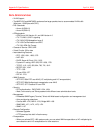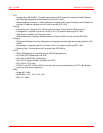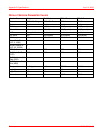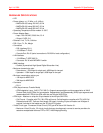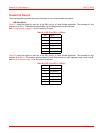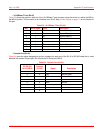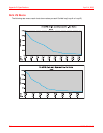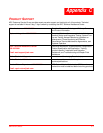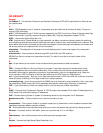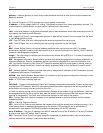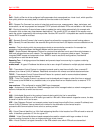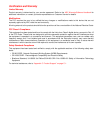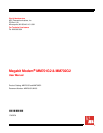
Glossary April 14, 2006
GL-2 MM70xG2-UM-03
gateway – A device (generally a router) that provides translation services to allow communication between two
dissimilar networks.
I
IP – Internet Protocol is a TCP/IP protocol that controls packet transmission.
IP address – A 32-bit address used in IP routing. The address consists of four octets separated by decimals. The
octets comprise a network section, a subnet section (optional) and a host section.
L
LAN – Local Area Network is a physically connected group of devices between which data transmission occurs at
high speeds over relatively short distances.
LLC – Logical Link Control is an encapsulation protocol for data that you transmit from the modem over the WAN
in 1483 Bridging/Routing mode.
LOF – Loss Of Frame is an error indicating that the receiving equipment has lost a frame.
LOS – Loss Of Signal is an error indicating that the receiving equipment has lost the signal.
M
MAC – Media Access Control is a physical address associated with a device such as a NIC. For modem
configuration, the MAC is used to map inbound traffic (from a remote IP address) to an internal (LAN) IP address.
Used with 1483 Bridging/Routing Mode.
margin – The noise margin in decibels that the modem must achieve with a BER of 10 -7 or better to successfully
complete initialization.
MIB – Management Information Base is a set of variables that define the configuration and status parameters for
network management. Network management stations can retrieve information from and write information to an
MIB. The Internet Engineering Task Force (IETF) specifies standard MIBS for certain types of devices, ensuring
any NMS can manage the devices. Vendors can specify proprietary MIBs for their devices to fit specific needs.
N
NAT – Network Address Translation provides the means to map private IP addresses (LAN IP addresses) to public
IP addresses (WAN session IP addresses).
NVRAM – Non–Volatile Random Access Memory is a medium for storing system configuration information, so the
information is not lost when the system is reset.
octet – A TCP/IP term indicating eight bits.
P
PAP/CHAP – Password Authentication Protocol and Challenge Handshake Authentication Protocol are two ways
to authenticate PPP sessions. With PAP, the modem sends authentication requests to the service provider and
authentication occurs only once during the life of the link.
In CHAP, the service provider returns an authentication challenge to the modem during authentication. CHAP can
be renegotiated during the life of the link. Also, both the modem and the service provider must support clear text
versions of the password. The CHAP host field must be the same on both ends of the session.
PDU – Protocol Data Unit is data as it appears at the interface between a particular sublayer and the sublayer
immediately below.
POTS – Plain Old Telephone Service.
PPP – Point-to-Point Protocol exists between the hardware layer and the network-layer interface protocols. It is a
widely used protocol for establishing connections on the Internet. PPP provides the set up and release of
connections for each session. PAP/CHAP provide the authentication for the PPP sessions.
proxy IP address – The proxy IP address is the WAN IP address for one of the 32 sessions. The proxy IP address
is used to enter static NAT entries. See IP address.
PVC – Permanent Virtual Circuit is a logical connection comprised of a predefined static route across a packet-
switched network that is always in place and always available.




